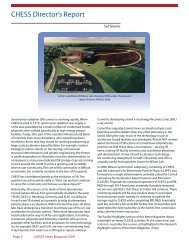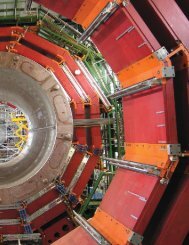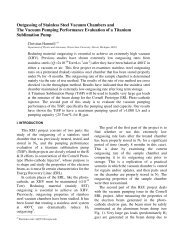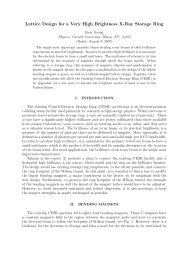Analysis and Optimization of Singular Value Decomposition Orbit ...
Analysis and Optimization of Singular Value Decomposition Orbit ...
Analysis and Optimization of Singular Value Decomposition Orbit ...
Create successful ePaper yourself
Turn your PDF publications into a flip-book with our unique Google optimized e-Paper software.
9<br />
TABLE V: Minimizing Corrector Redundancies<br />
1 : Decompose M CM by SVD.<br />
2 : Obtain the column vector v <strong>of</strong> V with the smallest singular value.<br />
3 : Remove the corrector corresponding to the largest element <strong>of</strong> v.<br />
4 : Repeat steps 1-3 until the condition number N < S <strong>and</strong> ḠM CM > SN C<br />
.<br />
as solid lines. To verify their accuracy, they are<br />
compared with the results from the Tao simulation,<br />
depicted here as the black dots, <strong>and</strong> the<br />
two agree very well.<br />
The nine undulators are located where there are<br />
local minima around the 50, 80, 110, 135, 160,<br />
190, 315, 360, 400 meter marks. The orbits here<br />
should be kept at a minimum while optimizing<br />
<strong>and</strong> eliminating huge orbit peaks.<br />
A. <strong>Optimization</strong> <strong>of</strong> the Current<br />
Configuration<br />
The program simply rearranges the 103 monitors<br />
but reduces the number <strong>of</strong> correctors to 58. The<br />
figure represents the new residues as the red envelope.<br />
The residual orbits here are more evenly<br />
distributed <strong>and</strong> eliminated the major peaks from<br />
the original configuration, cutting the maximum<br />
peaks by more than a half, while having a minimal<br />
effect on the undulator orbits.<br />
FIG. 6: SA: Residual <strong>Orbit</strong> After Corrector <strong>Optimization</strong><br />
12<br />
12<br />
10<br />
FIG. 5: SA: Residual <strong>Orbit</strong> After <strong>Optimization</strong><br />
Residual <strong>Orbit</strong> Sigma Μ m<br />
10<br />
8<br />
6<br />
4<br />
Residual <strong>Orbit</strong> Sigma Μ m<br />
8<br />
6<br />
4<br />
2<br />
0<br />
0 100 200 300 400<br />
s m<br />
2<br />
0<br />
0 100 200 300 400<br />
s m<br />
The residual orbit after applying both the<br />
monitor <strong>and</strong> corrector optimization programs is<br />
shown in Figure 5. A new constraint was placed<br />
on the monitor redundancy algorithm due to its<br />
sensitivity. Monitors are placed before <strong>and</strong> after<br />
the undulators to increase the monitoring power<br />
at these elements, but the program deletes the<br />
first <strong>of</strong> these monitors. Therefore, an exception<br />
list <strong>and</strong> a new criterion indicating the minimum<br />
number <strong>of</strong> monitors required are introduced.<br />
Finally, the original correction scheme was optimized<br />
again using only the corrector program.<br />
This procedure assumes that the current lattice<br />
lack any significant monitor deficiencies <strong>and</strong> redundancies.<br />
It removed nine correctors while<br />
still improving the residual orbits, as depicted<br />
in Figure 6.<br />
VIII.<br />
CONCLUSION<br />
The program written in Mathematica takes as<br />
input the derivative data from Tao to construct<br />
the generalized response matrices. It separates<br />
the four optimization algorithms so they can be









